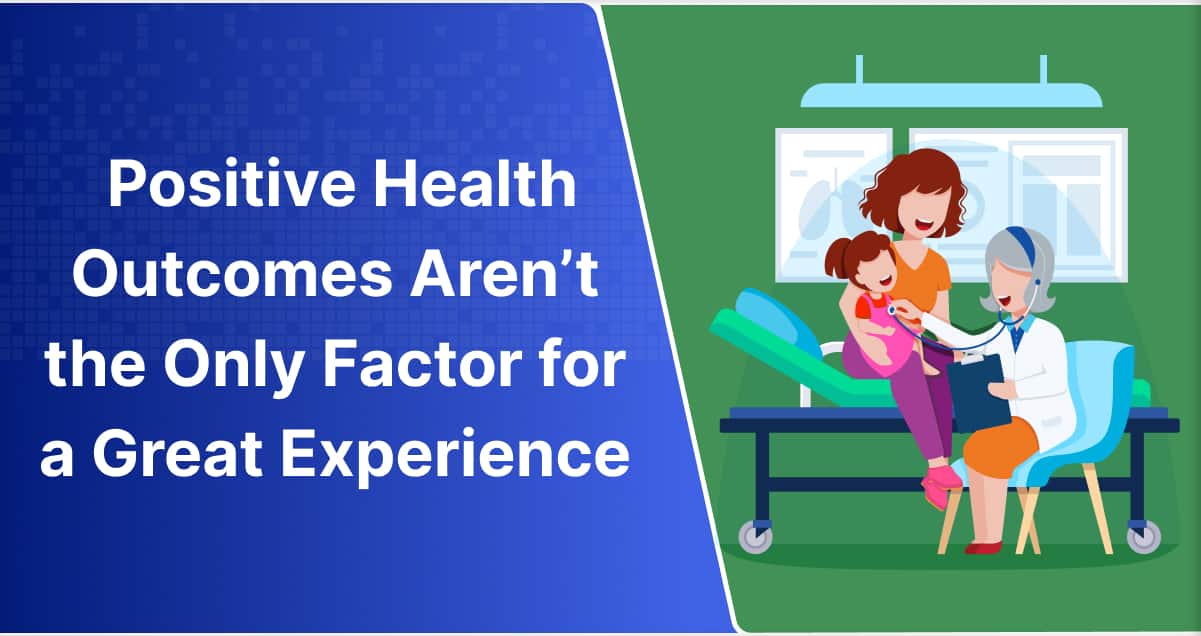Improving the patient experience is about more than being friendly and providing efficient service. It also encompasses personalized care, effective communication, proactive engagement, and a deep understanding of patients’ needs and preferences.
Strengthening your patient experience strategy isn’t easy, but it may be the key to boosting revenue.
The patient experience has become closely intertwined with online reviews and ratings in today’s digital age. Online platforms and review websites have provided patients with a platform to share their healthcare experiences, both positive and negative.
72% of patients rely on online reviews to make decisions about their healthcare choices, including selecting a new healthcare provider, choosing a hospital or clinic, or even deciding on treatment options.
Adopting patient experience strategies that prioritize convenience, personalization, communication, and empathy can help healthcare providers offer care that delights patients. In this article, we will explore 11 strategies grouped into 4 sections for improving the patient experience.
Why Should You Prioritize Improving the Patient Experience?
Improving the patient experience should be a priority for every healthcare provider and organization. While the primary goal of healthcare is to diagnose and treat illnesses, the way in which care is delivered significantly impacts patient outcomes, satisfaction, and overall healthcare system performance.
Here are key reasons why improving the patient experience is so important:
1. Patient Satisfaction and Loyalty
A positive patient experience directly correlates with higher levels of patient satisfaction. When patients feel heard, respected, and actively involved in their care, they are more likely to report higher levels of satisfaction with their healthcare encounters.
Satisfied patients are also more likely to become loyal to a particular healthcare provider or organization, resulting in increased patient retention rates and positive word-of-mouth referrals. On the other hand, negative experiences can lead to patient dissatisfaction, attrition, and potential damage to the reputation of the healthcare entity.
2. Improved Health Outcomes
A patient-centered approach that focuses on enhancing the patient experience has been shown to contribute to improved health outcomes. When patients are actively engaged in their care and have a clear understanding of their conditions, treatment options, and self-care measures, they are more likely to adhere to prescribed treatments and make positive lifestyle changes.
Effective communication, personalized care plans, and support systems in place can lead to better disease management, reduced hospital readmissions, and improved overall patient health.
3. Enhanced Patient Engagement and Empowerment
Improving the patient experience encourages patient engagement and empowerment. By involving patients in decision-making processes, sharing information transparently, and respecting their preferences, healthcare providers can empower patients to take an active role in their own care.
Engaged patients are more likely to follow recommended treatments, participate in preventive care measures, and proactively manage their health. By fostering patient engagement and empowerment, healthcare providers can create a collaborative care environment that benefits both patients and healthcare teams.
4. Financial Considerations
Enhancing the patient experience can have positive financial implications for healthcare organizations. Satisfied patients are more likely to return for future care, leading to increased revenue streams.
Additionally, patient loyalty and positive word-of-mouth referrals can attract new patients, expanding the patient base. In contrast, poor patient experiences can result in negative reviews, decreased patient volumes, and potential financial losses.
Investing in improving the patient experience can ultimately contribute to the financial sustainability and growth of healthcare organizations.
5. Regulatory and Reimbursement Landscape
The regulatory landscape of healthcare is evolving, with an increasing emphasis on patient-centered care and quality outcomes. Regulatory bodies and payers are recognizing the importance of patient experience metrics and incorporating them into performance evaluations and reimbursement models.
Healthcare organizations that prioritize the patient experience are better positioned to meet regulatory requirements, achieve favorable quality ratings, and receive appropriate reimbursements.
Make Care Convenient When Improving the Patient Experience
Enhancing care accessibility and convenience is our first suggestion for improving the patient experience. However, providing such care goes beyond trying to fit all patients who call into your schedule.
With average appointment wait times on the rise, patients in cities may soon experience average waits of nearly a month. For those who are able to wait, some patients may not have reliable transportation or other barriers to appointment fulfillment.
Missed appointments are also detrimental to healthcare organizations, which lose about $150 billion every year in the United States. With an estimated average cost of $200 for each one-hour time slot missed, care accessibility helps organizations avoid unexpected loss.
By focusing on accessibility and convenience, healthcare entities can ensure that patients receive the care they need in a timely and hassle-free manner. Here are three ways you can help make patients feel care is more accessible and convenient.
1: Embrace Telehealth
Telehealth has revolutionized the way healthcare is delivered, especially in recent years. Healthcare providers can offer virtual consultations during telehealth appointments, enabling patients to receive medical advice and treatment remotely.
Telehealth eliminates the need for patients to travel to healthcare facilities, saving time and reducing the burden of transportation. It is particularly beneficial for individuals with limited mobility, those residing in remote areas, and those with non-emergency medical concerns.
According to the J.D. Power 2022 U.S. Telehealth Satisfaction Study, “94% of telehealth users said they ‘definitely will’ or ‘probably will’ utilize telehealth to obtain medical services in the future.”
While not all services can be provided remotely, most patients would rather handle several types of appointments digitally. Even with its limitations, offering telehealth services can help with improving the patient experience.
2: Enhance Digital Patient Portals
Digital patient portals serve as a gateway for patients to access necessary services and enable greater patient involvement. These may help them request medical records, communicate with providers, schedule appointments, receive test results, and more.
Patient portals make it easy for patients to find, figure out, and manage various health-related functions from organizations’ websites. For improving the patient experience, portals should be noticeable, explicitly clear and user-friendly, and designed to make relevant processes easier.
For example, ChartRequest partners implement a button on their websites that lead patients to their organization’s ChartRequest portal. This helps patients and other requestors get the records they need quickly and easily without picking up a phone.
3: Streamline Appointment Scheduling
Appointment scheduling is a crucial aspect of accessible and convenient care. By implementing efficient scheduling systems, healthcare providers can reduce patient wait times and ensure that appointments are readily available.
Offering online platforms, mobile apps, or automated phone systems for appointment booking simplifies the process for patients. This also enables them to select suitable dates and times based on their preferences. Eliminating calls for appointment-related issues is a great way of improving the patient experience in 2023.
Additionally, clear communication regarding appointment availability and any potential delays helps manage patient expectations and minimizes frustration. This can help reduce the 20% average number of patients who have switched doctors due to long waiting room times.
Ensure You’re Focusing on a Patient-Centered Approach
A patient-centered approach involves empowering patients to play an active role in their healthcare. This motivates patients to take their care seriously, which is helpful for supporting positive outcomes and improving the patient experience.
Here are three key strategies to adopt a patient-centered approach:
4: Listen to Your Patients and Make Them Feel Heard
Focus on tailoring healthcare to meet individual patient needs, preferences, and goals. This approach requires healthcare providers to consider patients’ values, backgrounds, and personal circumstances when formulating treatment plans.
Unfortunately, over 50% of patients feel ignored when discussing issues with their providers.
If you’re researching strategies for improving the patient experience, you likely already work hard to offer the best care possible. Even with this in mind, it’s important to communicate to patients that you hear what they’re saying.
5: Offer Patients Personalized Communication
Communication plays a vital role in patient care. By personalizing communication, healthcare providers can build trust, foster engagement, and improve patient satisfaction.
Personalized communication doesn’t always need to be extra work. For example, setting up appointment reminders with dynamic name fields and pleasant messages can delight patients.
Patients may also feel more comfortable between appointments if they’re provided with personalized instructions, health education materials, and follow-up messages. This helps patients feel valued, understood, and well-informed about their healthcare journey.
6: Embrace Patient Feedback
Criticism is difficult to hear, but patient feedback is the best way to find issues you may not know exist. Embracing the patient’s perspective to eliminate these issues is crucial for improving the patient experience.
Healthcare providers should also actively seek feedback through surveys or online research to gain insights into patients’ perspectives and expectations. This feedback can shed light on areas that require improvement industry-wide and highlight successful initiatives that should be expanded.
By understanding what patients want, healthcare organizations can continuously enhance their services, address concerns, and ensure patient satisfaction. These factors can all contribute to improving the patient experience.
Improve Outcomes and Simplify Care Coordination
Seamless care coordination involves effective communication and collaboration among healthcare providers across different settings. Any patient who sees a healthcare provider other than their PCP has likely experienced care coordination.
Here are three key strategies to achieve seamless care coordination:
7: Prevent Patient Care Coordination Homework
Care coordination is crucial for ensuring patients receive a unified care plan across multiple providers. However, patients shouldn’t need to be a middleman to provide their medical information.
ChartRequest is a release of information and care coordination solution that makes it easy for providers to exchange patient data. Our extensive security and compliance features mixed with our user-friendly design can support your efforts of improving the patient experience.
By implementing robust care coordination strategies, healthcare organizations can streamline the flow of information, enhance communication, and facilitate collaboration among different healthcare teams.
8: Utilize AI and Data Analytics
AI algorithms can analyze vast amounts of patient data, identify patterns, and generate personalized treatment recommendations. This can help healthcare providers make informed decisions, improve diagnosis accuracy, and optimize care pathways.
Artificial intelligence (AI) and data analytics improve care outcomes and ease administrative burdens by providing valuable insights and predictive analytics. Reducing such burdens is also beneficial for improving the patient experience because happier employees are more likely to delight patients.
9: Improve Discharge Planning
Effective discharge planning is crucial to ensure a smooth transition for patients from hospital to home or other care settings. It involves comprehensive planning, clear communication, and coordination between healthcare providers, patients, and their families.
When improving your discharge planning strategy, ensure it includes providing patients with clear instructions, follow-up appointments, and self-care measures.
By involving patients in the planning process and addressing any concerns or questions they may have, healthcare providers can minimize the risk of complications, reduce readmission rates, and enhance patient satisfaction.
Section 4: Empathy and Cultural Sensitivity
Empathy and cultural sensitivity are integral components of delivering patient-centered care. By recognizing and valuing patients’ unique backgrounds and situations, healthcare providers can create a supportive and inclusive environment.
10: Create a Comfortable Environment for All Patients
It’s clear when a healthcare organization pays special attention to creating a comfortable environment. For example, a waiting room with art and plants will generally feel more cozy than a room with bare walls.
Physical surroundings play a crucial role in creating a comfortable environment. Thoughtful considerations, such as comfortable seating, soothing lighting, and gentle or familiar music, can help alleviate anxiety or discomfort.
For some time-based options, try setting up seasonal decorations and keeping your magazine selection up-to-date. These small steps can go a long way in improving the patient experience.
11: Emphasize Empathy and Compassion
Empathy and compassion are essential qualities for healthcare professionals to possess. By actively listening to patients, showing empathy toward their concerns, and demonstrating compassion in their interactions, healthcare providers can create a caring and supportive environment.
Simple gestures, such as maintaining eye contact, using reassuring language, and expressing genuine empathy, can significantly impact the patient experience. Healthcare organizations can promote empathy and compassion through training programs, mentorship, and fostering a culture that values patient-centered care.
Interested in Improving the Patient Experience During ROI?
The patient experience lies at the core of healthcare delivery. By striving for excellence in every aspect of care delivery, we can shape a future where patients receive healthcare experiences that are compassionate, efficient, and truly transformative.
ChartRequest is a release of information and care coordination software that’s meticulously cultivated for improving the patient experience. By understanding the perspectives of all types of requestors, we can target areas of confusion, frustration, and inefficiency.
Understanding the patient perspective is perhaps the most important for improving the patient experience. Traditional methods of ROI simply aren’t feasible for the average patient nowadays.
For example, fax is an increasingly inaccessible method of acquiring medical records for patients. While some home printers have built-in fax functionality, the additional costs and setup aren’t worthwhile for most people. This goes doubly for imaging CDs, which most modern computers aren’t built with the optical drive necessary to read them.
Meanwhile, 85% of Americans have a smartphone and most households also have a computer. This makes digital methods of exchanging PHI the most convenient and accessible for most people.
Additionally, healthcare organizations that leverage a release of information solution can significantly reduce their team’s time dedicated to ROI. This means simpler compliance, faster turnaround times, and a greater ability to focus on improving the patient experience.
Want to learn more about how ChartRequest can help your organization with improving the patient experience? Select “I Am a Healthcare Provider” and fill out the short form for a personalized assessment of your organization’s needs.








